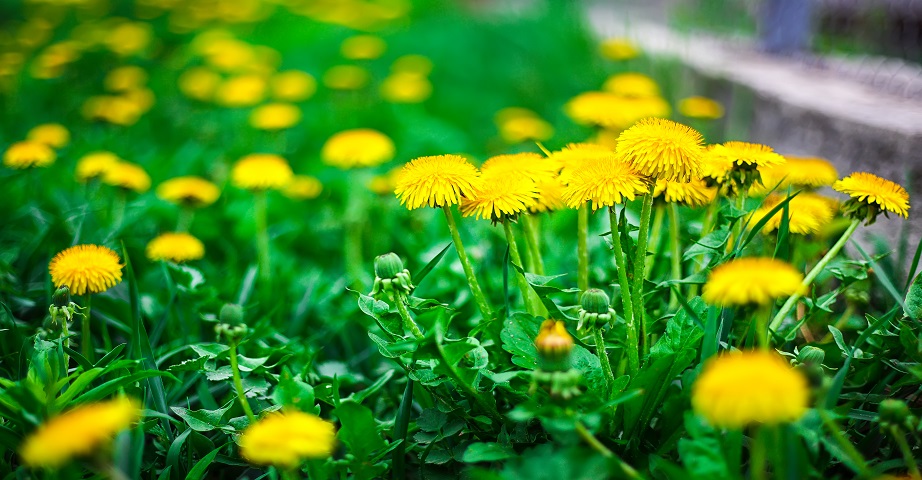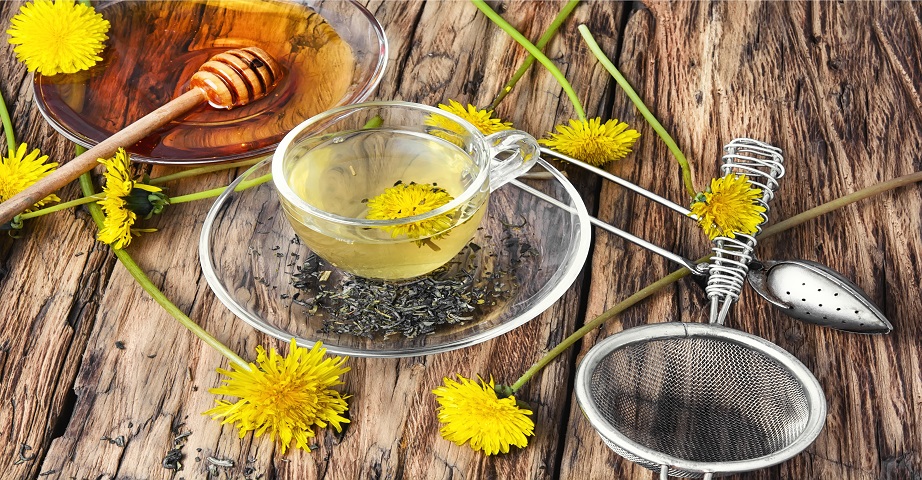Dandelion - an unnecessary weed or a valuable raw material?

Dandelion is a perennial commonly found in the temperate climate zone. It is an edible plant, which is valued by some because of its numerous pro-health properties, and by others is considered a weed.
How is it really? Is it worth using products and preserves from the plant? Is dandelion different from field milk thistle?
What does dandelion look like and where does it grow?
Dandelion (Taraxacum officinale), also called a common dandelion or frog flower, is a perennial plant reaching about 40 cm in height. Its Latin name comes from the Greek word "taraxic" meaning "inflammation", and "akeomia", that is, treatment.
It is a perennial from the Asteraceae family, which is commonly found in Europe, Asia and North American regions. The dandelion can also grow in South America, especially around Mexico. In Poland, the plant is most often found in meadows, but also on lawns, wasteland or roadside. In agriculture, the dandelion is considered a weed, difficult to eradicate and easily spread by the wind.
The dandelion has a long and thick pile-type root, which from the outside takes a yellowish-gray color, while inside it is distinguished by a white color. The stems of the plant are leafless and empty inside. The dandelion blooms twice a year - the first flowering is in the period from May to July, and the second - in autumn. Intensely fragrant flowers of the plant are yellow and collected in a capitulum. After finish blossoming, the inflorescence of the dandelion resembles a white, fluffy ball.
In all parts of the dandelion can be found a white, bitter and burning liquid, which is milk juice. And although the dandelion is often treated as an unnecessary plant, it is valued by enthusiasts of herbal medicine, due to the wealth of valuable ingredients and possible health benefits. In herbal medicine, all parts of the plant are used - both flowers, leaves and dandelion roots. Flowers are usually picked in May, stems - during flowering, in turn, roots, in spring or autumn.
The dandelion, also referred to as the common dandelion, is classified as a health-promoting plant by the World Health Organization. However, much earlier, in ancient times, in the areas of Greece and Rome, infusions from the leaves of the plant were used to treat skin diseases. In the middle ages, raw material extracts were used to relieve liver and spleen conditions, while in traditional Chinese medicine, dandelion was used in rheumatism and inflammatory therapy. In Polish folk medicine, the plant was used during gastrointestinal problems, as well as during infections and colds.
Dandelion and field milk thistle - how do they differ?
A dandelion is very often called a field milk thistle. Is it one and the same plant, or maybe a field milk thistle and a dandelion are two distinct species?
A dandelion and a field milk thistle are similar but different plants.
The dandelion has leaves arranged in a rosette that grow by themselves from the same place. Usually, several stems with flowers also grow from the rosette. There is always one flower on one stem. The stems are leafless, and after flowering they change in a dandelion clock. The dandelion is edible and can exhibit health-promoting properties.
In turn, the field milk thistle grows on a stem covered with slightly prickly leaves, which can grow at different heights. In addition, there is always more than one flower on one stem. The field milk thistle is not edible and does not have health-promoting properties.

Active ingredients present in dandelion
The dandelion may have pro-health properties due to the wealth of active substances. In phytotherapy, the dandelion root is most often used. This is because it contains compounds such as:
- triterpenes,
- phytosterols,
- inulin,
- phenolic acids,
- sesquiterper compounds,
- potassium salts.
In the leaves of the plant, which are also often used in herbal medicine, in addition to triterpene compounds, can also be found:
- flavonoids,
- phenolic acids,
- carotenoids,
- minerals such as potassium, magnesium and silicon,
- vitamins, such as vitamin C, A or B vitamins.
In the plant can also distinguish compounds such as resins, gums, waxes, fatty acids, proteins or enzymes.
Dandelion - properties. What does the common dandelion help with?
Available scientific data indicate that dandelion is a plant with a wide spectrum of activity.
The frog flower can take care of the proper functioning of the digestive system, stimulating the secretion of gastric juice and bile. The vegetable raw material can also support the functioning of the liver and its purification. The dandelion can facilitate the excretion of deposits and toxins from the body, as well as act diuretic.
Because the dandelion root can contain as much as 40% inulin, an insoluble fraction of dietary fiber, the underground part of the plant can be a natural prebiotic, thus contributing to an increase in the amount of "good bacteria" in the intestines. The root of the raw material can also inhibit the development of harmful microbes in the digestive system.
Inulin and other active compounds present in the root of the dandelion clock cause that the plant may have anti-diabetic potential. The dandelion can stimulate the production of insulin, while facilitating the maintenance of normal blood sugar levels. The plant can also contribute to lowering glucose levels in the blood serum among people struggling with diabetes.
Animal studies also suggest that the dandelion may help to lower triglyceride levels in the blood serum, as well as reduce total cholesterol levels in the blood. Scientists also believe that the dandelion extract may have a beneficial effect on adipogenesis and lipid metabolism in the body.
The dandelion, especially its overground parts, may also exhibit antioxidant and anticoagulant effects, and may favourably affect the hemostatic system. Thus, the plant and its extracts may be promising in the prevention of cardiovascular diseases, especially those related to homeostasis disorders and oxidative stress. In turn, the dandelion roots can exhibit antioxidant, anticoagulant and antiplatelet properties, inhibiting platelet aggregation.
The dandelion can also strengthen the body's immunity and have anti-inflammatory, antibacterial and antiviral effects. The plant also has antioxidant properties, and thus can eliminate free radicals and reduce oxidative stress, while delaying the aging process. In addition, the frog flower can have a beneficial effect on the hair, stimulating their growth and showing anti-seborrheic effect. The plant can nourish the hair and improve their condition. In addition, the dandelion can accelerate the wound healing process and support skin regeneration, as well as smooth and soften the skin.
Dandelion and weight reduction
During the study in the mouses have shown results suggesting that the dandelion may have the potential to counteract obesity by inhibiting pancreatic lipase activity and increasing triglycerides in the plasma. In addition, other data have shown that the dandelion extract can contribute to the reduction of body weight and lipid parameters.
The dandelion can be a support among people who are slimming also due to the high content of dietary fiber, which improves intestinal peristalsis and provides a feeling of satiety. In addition, the raw material may limit cravings for sweets, which may also translate into weight loss.
However, further scientific research is needed to confirm the beneficial effect of the dandelion on weight reduction.

Dandelion - purpose
Dandelion is a plant with many health-promoting properties that can be used every day in many ways. In the spring, salads or pesto can be prepared from the leaves of the raw material, while dried and roasted dandelion seeds can be used as a substitute for coffee. From the plant can also be created a tincture or wine. Infusions, soups or dandelion syrups can also be a good solution.
In Asian countries, the leaves of the plant are fried and served with brown rice. In Turkey, fresh and dried leaves of the frog flower are used as a seasoning. In some European countries, flower buds of the plant are also used - they are preserved in vinegar, and their taste resembles the aroma of capers.
How to make an infusion of dandelion root?
From both the root, flowers and leaves of the plant, can be used to make brew.
To prepare tea from the dandelion flowers and leaves, you need to pick them in the spring when they are young. After thorough washing, you need to put 6-7 leaves and flowers in a cup, and pour hot water. Then cover and leave the mixture for 15 minutes. After this time, you need to strain the brew and drink the prepared drink.
To create an brew from the root of the dandelion clock, you need to wash and chop the underground part of the plant, and then bake it in the oven for about 2 hours. Two teaspoons of the prepared mixture should be poured with hot water and left covered for 10 minutes to infuse, and then drink. The dandelion tea can help digestion or reduce inflammation.
How to make dandelion syrup? - Recipe
To prepare the dandelion syrup, you need:
- 300 fresh flowers,
- 1 liter of water,
- 1 lemon,
- 1 kg of sugar.
The flowers should be put in a pot and poured with hot water, then over low heat boil for about 10 minutes. Then put the pot away for 24 hours in a cool place. After a day, strain the decoction, add sugar and lemon. Mix the ingredients and cook for about 3 hours until a honey-like consistency. Split the resulting syrup into jars. The product will be great, among others, as a support during infection and inflammation.
Dandelion - side effects and contraindications
The dandelion is considered a safe substance. However, the plant should not be used by allergic people - strong allergic reactions may occur. In addition, due to the richness of bitter substances and the stimulating effect on the secretion of gastric juice, excessive consumption of products from the frog flower can contribute to the occurrence of undesirable gastrointestinal symptoms, such as nausea, diarrhea, indigestion or heartburn.
Preparations and dietary supplements containing the dandelion should not be used without consulting a doctor also by people struggling with diseases of the bile ducts or intestines, as well as with gastric hyperacidity.

